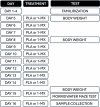1-Methylxanthine enhances memory and neurotransmitter levels
- PMID: 39820866
- PMCID: PMC11737676
- DOI: 10.1371/journal.pone.0313486
1-Methylxanthine enhances memory and neurotransmitter levels
Abstract
1-Methylxanthine (1-MX) is the major metabolite of caffeine and paraxanthine and might contribute to their activity. 1-MX is an adenosine receptor antagonist and increases the release and survivability of neurotransmitters; however, no study has addressed the potential physiological effects of 1-MX ingestion. The aim of this study was to compare the effect of 1-MX on memory and related biomarkers in rats compared to control. Memory (escape latency in the Morris water maze test), neurotransmitters (acetylcholine, dopamine, gamma-amino butyric acid (GABA)), and neurochemicals (BDNF, catalase, glutathione, Amyloid Beta and cyclic GMP) were analyzed from whole brain samples in young (8-weeks-old) and aged (16-months-old) rats following 12 days of supplementation (100 mg/d HED of 1-MX [UPLEVEL®, Ingenious Ingredients L.P., Lewisville, TX, USA]) via oral gavage. 1-MX supplementation reduced escape latency by 39% in young animals and 27% in aged animals compared to controls (both p<0.001). Additionally, 1-MX increased the levels of acetylcholine, dopamine, GABA, and cyclic GMP (all p<0.001). Furthermore, 1-MX supplementation led to reduced amyloid beta and higher catalase, BDNF and glutathione concentrations (p<0.001). Collectively, our findings suggest that 1-MX may have cognitive-enhancing and neuroprotective properties.
Copyright: © 2025 Jäger et al. This is an open access article distributed under the terms of the Creative Commons Attribution License, which permits unrestricted use, distribution, and reproduction in any medium, provided the original author and source are credited.
Conflict of interest statement
RJ, MP, SDW and KL are researchers and principals of Ingenious Ingredients, the sponsor of the study, and inventors of a patent application for the use of 1-MX but have been involved in data collection or analysis. RJ, MP and SDW serve on the scientific advisory board and KL is the CEO of NNB Nutrition, the manufacturer of the 1-MX used in this study. AG is employed by Radiant Research Services Pvt. Ltd., and Radiant Research is a CRO who has received funding from Ingenious Ingredients to conduct this study. GMT provides consulting services, including statistical analysis and dietary supplement formulation, through Tinsley Consulting LLC but has no conflicts of interest related to the use of 1-MX. SA is employed by Iovate Health Sciences, a company selling dietary supplements. SA and MO declare no competing interests. This does not alter our adherence to PLOS ONE policies on sharing data and materials.
Figures




References
MeSH terms
Substances
LinkOut - more resources
Full Text Sources
Medical

